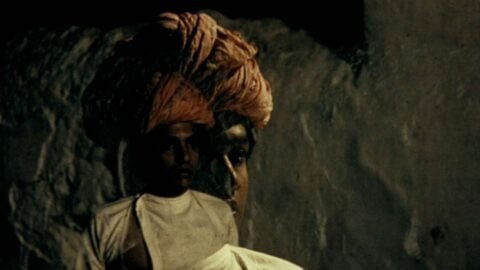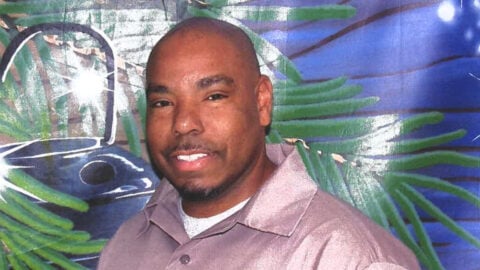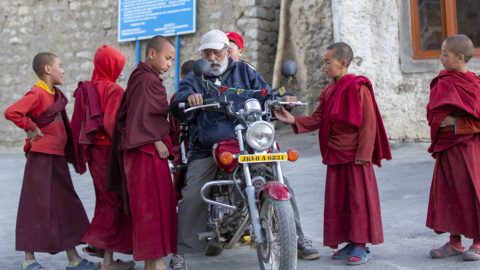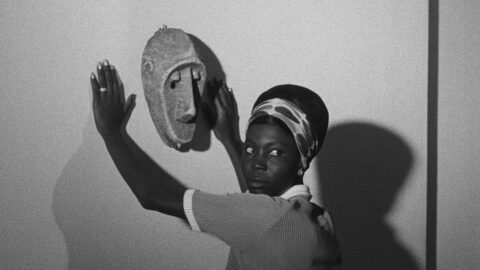Interview: Shlomi Elkabetz
Directed by Israeli brother-and-sister team Schlomi and Ronit Elkabetz, Gett: The Trial of Viviane Amsalem zeroes in on one woman’s attempt to obtain a divorce from her husband in a rabbinical court. Screening tonight in the New York Jewish Film Festival at the Film Society of Lincoln Center, the film had its world premiere last May at Cannes, where it was a standout in Directors’ Fortnight.
“Completing a trilogy that they began with To Take a Wife (04) and 7 Days (08), the Elkabetzes set themselves certain formal limitations to unearth profound drama and mystery from the dry-sounding scenario . . . According to accepted archaic law, Viviane (Ronit Elkabetz) can only legally finalize her divorce with the complete consent of her husband, Elisha (Simon Abkarian). Supported by her lawyer (Menashe Noy), she returns again and again to court, with friends and family called as witnesses, but the man to whom she is unluckily bound holds firm, for increasingly opaque reasons in which anger, love, and pure male prerogative are merged together. As the months go by, time itself seems suspended, while the couple’s connection (or lack thereof) is increasingly suggested by what isn’t explained rather than what is . . . Part of the appeal of this twistily written film—which effortlessly shifts from courtroom drama to feminist commentary to intense melodrama to black farce to some combination of existential conundrum and folk tale—lies in the way it maintains the impossibility of truly characterizing a relationship to outsiders” (FC July/August 2014).
At Cannes, FILM COMMENT spoke with Shlomi Elkabetz about planning out the rigorous camerawork, the secrecy of the rabbinical court, and why he considers Gett to be their most American film.

How extreme is Viviane’s case? It seems as if it could be one of the worst ones out there.
No, the worst one we know is a woman who is still waiting over 23 years for a divorce. Many wait for 15 years. And when I was researching the subject matter, I wanted to see what was going on. I know the laws and I have a fairly good grip on biblical Hebrew. And for my imagination it’s enough for me to know that she wants the divorce, and he doesn’t want to give her the divorce—I can write 20 scripts, I don’t need to sit in on the trial. But I was afraid that I wouldn’t be precise. I gave the script to different rabbinical judges and lawyers, and everybody read the script and marked and helped me to make it realistic.
Did you observe an actual court?
I went to a divorce ceremony. I was still really afraid because I didn’t have the image—I needed the image, I’m a film director. I just need one picture and from there I can fly. There are open-door trials, but you cannot go into the marital court. It’s a secret. And I went to the court somehow. I said, I am writing an article about marriage and divorce, I’ve never seen a gett. There was a really nice rabbi there who told me, come, stand on the side, if the couple agrees, you can see the gett. I go to court, I wait, the couple comes, and the lawyer says “No problem.” In the court they were afraid the husband was going to say no [to the divorce]. The husband got a little crazy over the years, he was not 100 percent well, but still he has to say yes—you cannot force him to say yes. And at a certain point, she closed her eyes and waited, and the room was still. When she got the divorce… I don’t know if any of us can imagine what it means to do anything for so many years for something everybody knows you deserve—your freedom.
When we had this image in our head, it was like, OK, this is it, we have everything. We have the protocol, we have the script, we have the characters, we have the image, we know what we want to say, what we want to tell. What we do with this film is open the door for people to see what’s happening in the rabbinical court. Now, the rabbinical court is an open-door court because of the film.
Did the laws change after the movie came out?
No, no, it didn’t happen yet. With the film, effectively we could see what’s happening in the rabbinical court. I think the film will create great dialogue. It will create a movement in a way, but I don’t know if it will change the law—the law hasn’t changed for the last 4,000 years. In Israel, the civil law and the religious law are one. We are caught in between history and present day. It’s very difficult.

The film has a feminist strain in that we strongly feel the divorce should be the woman’s right, but you can get caught up in the family drama and forget about rights for a while. Yet you’re able to return to the idea without making it the driving issue. It’s more about her as an individual.
The film is not a [newspaper] article. I hope the film is an act—a demonstration—but it has to be a film as well. And it’s important that people understand how absurd it is. We thought about the audience throughout the shoot—we never took an objective shot in the film.
Yes, it’s all point-of-view shots.
It’s all point-of-view shots. We don’t believe it’s objective—so let’s shoot the film the way the court actually is. And it was amazing to discover in the first days of the shoot, even though we changed the point of view every few seconds, the truth does not change. The truth of the moment doesn’t change. As in, for example, Rashomon where when you change the POV of the story, things change. From any angle you look at it, you agree that Viviane deserves to be a free woman.
The looks between the participants in the court are so important. And there is something subtle going on with the gazes from Viviane’s lawyer especially.
Viviane’s waiting to get a divorce, she’s beautiful, and her lawyer’s looking at her from time to time. The film opens with this shot—we see his face gazing. We don’t know it’s at her, but he is gazing down at the place where she’s sitting, with a very tender look. But even if he feels something towards Viviane, he would never risk anything, because then he would risk the whole trial. Maybe he doesn’t even know he feels something for this woman.
How did you choose your cinematographer? Looking at the small courtroom where it all takes place, it seems you would want someone who knows how to work with that kind of space, almost like studio television.
It was a very interesting DP, Jeanne Lapoirie. She doesn’t shoot TV at all, she shoots a lot of documentaries, and feature films as well. It was very challenging to shoot it this way for both of us. For me and Ronit and for Jeanne, it was tough to create and re-create the space again everyday. The lighting is the key for every film, and here we don’t have exterior shots, but we understood that if we manage to bring the outside inside through the light, we can have something very interesting. Every day we asked what kind of day is it today outside: is it winter? Is it summer? Is it early morning? Is it cloudy? Is it a grey day? Is it hot? How do we re-create the light? We put cold neons to wash the room, and then we try to create a conflict between the cold neon light, the blues inside, and the light that we bring from outside. We shot this film for eight weeks.

The sound design is also done with great care, both the courtroom dialogue and the scenes in the waiting room.
Yes, the sounds that you hear of the people, the women shouting, were recorded secretly in the rabbinical court. There’s an Israeli documentary film that was made with a secret camera and microphones in the court. I know the director, and I asked her to share some sounds from her documentary—her characters are real. So it’s even more authentic in a sense. The story seems so far-fetched—you don’t believe it’s true, you know? But it’s so realistic, it’s so true. And this trial is not just a trial of Viviane Amsalem, it’s a trial of society.
There seems to be a spectrum of religious beliefs among the people who come to the court. The requirement of wearing a yarmulke in the court becomes another point of tension in a way.
Elisha got further away from the religious life, but he knows the language very well, he knows his people, he knows how to talk to them. Viviane comes from a traditional family. As for the protocol, when you go to religious court, you are obliged to put a yarmulke on and women have to cover their heads. Some of the rabbis will not let you in if you don’t wear your yarmulke, and some are more progressive because people’s eyes are on them now with the press—they don’t want to lose the power that they have, so they start to let people come without the yarmulke. But some would say: “Put on your yarmulke, cover your hair! Wear something more modest!” They would shout at you. They can be very rude.
There’s that wonderful scene when Viviane decides to wear a red dress.
She’s so tired—she woke up this morning, she wants to be alive, she wears something red, for once. And she makes a mistake. She won’t wear red again.
I’m guessing there wasn’t much improvisation during filming, since the energy of the exchanges seems so deftly choreographed.
There’s not even one inch of improvisation. That’s because of the language—it’s very complex, a different type of Hebrew. You can improvise Shakespearean language, improvise Chekhovian, but it’s very difficult to improvise this language. So we had everything prepared: I just wanted the actors to know the text by heart. Before the shoot, I gave them a lot of images and I asked them to say the text. The images would be completely disconnected from the film. We did not analyze the text—we would try to work with simple images, with sensations, and slowly we started to advance. We shot everything so many times because of the point-of-views, and at a certain point it was there, you know?
You collaborate closely with your sister, Ronit. How do you divide the work of writing and directing?
We have worked for 10 years together now. We love each other very much, we are really connected, we are infatuated with each other. When we write a script, we go away for one month somewhere, maybe in Paris—the first time we went to New York and we closed ourselves in the apartment. We lived together for one month, we write sometimes, and then we rehearse together.

So you each play the parts?
We each play the parts—I play Viviane, she plays Viviane, I play Elisha—we play all the parts for these three months. And we rehearse and rehearse, and while we rehearse, we talk about how we would like to do it. And we argue a lot. This time we argued a lot about the light—we had very interesting arguments, I wish I had recorded them. Making a film is something very internal, but the film itself is extrovert work; and for the viewer it’s very internal. After we finish our arguments and debates, we do the shoot and we hardly talk. We don’t even talk by the end of the shooting day—maybe every other day we have a conversation about what happened and what we planned, and we just look at each other, and we know. Because we spoke so much before—for two years we talked before the film! When the shoot comes, it’s our time to look, to look at each other, to look at the picture, to listen, to very attentive, to be sensitive. We never do playbacks, we hardly stand by the monitor. I see, I know if I like it. Then we edit together, we go through the whole process. It’s a total collaboration. For this film and the last one, I also produced.
Did you have any touchstones in film, dramas or documentaries?
One of my favorite films of all time is A Woman Under the Influence.
I love that movie.
I love everything about it. I love every inch, every frame, every sound—it’s a film I know, I remember. I can talk with this film, I can have a conversation with it—it’s not just a story for me. And when making Gett, we also talked a lot about Dreyer’s The Passion of Joan of Arc, Bresson’s Trial of Joan of Arc, all the different Joan of Arc trials.
What about literature, or theater? The movie is almost like being inside a play.
I love Chekhov, I love Tennessee Williams. I love still photography, I love all the American film noir that was made in the Forties. I lived in New York, and I did some theater myself as an actor. I never went to film school, but I took some classes at the Strasberg Studio. Everything is there for me—all the plays I love, all the photos that I saw, all the experience that I’ve had. It’s funny to say this, but for me this is the most American story I could ever write.

American in what sense?
Just because of the simplicity of the story. “You say yes and I say no”—the essence of the drama of the film, not the film as a whole. It’s something that I usually see in American scriptwriting, something very defined. It’s very much like when you go to drama school and you learn what’s the simplest conflict. And that’s what sometimes makes American cinema so great. When we finished writing the script, I told Ronit I never thought we could write like this. Even though my biggest influences in dramaturgy are American, still I never thought I would be able to have something so simple.
What was the original inspiration for the story? Did you know people who had gone through this?
First, the film is a part of a trilogy that we directed over the last 10 years and the inspiration for the character Viviane. We wanted to make the three films about the journey of a person who tries to be free. The first one we made, To Take a Wife [04], is more personal, drawn more from our own lives and our point of view on our mother’s life. Then the second one, 7 Days [08], moves further from this. Viviane is inspired by our mother, but our mother never went for a gett, a divorce. I know many, many women who did go for a divorce, and hundreds of women who wait for many years, and thousands of women who wait under three years, under two years. It’s very tricky when you go and collect this information in Israel. But imagine that you have to wait two years for something that we all agree is a lawful right. It’s the right of one person to live with whom he wishes.
Did you have the idea of making three movies from the beginning?
We had an idea to write the three films 10 years ago. But it is a bit pretentious to say, as a beginner filmmaker, that I knew I wanted to make a trilogy. We did know the character very, very well, but we were very open because we watched it progress with Viviane. Sometimes it’s just the audience, sometimes it’s the critics, the scholars who write articles—Viviane talks back to you through these people. And she progresses, and then the story that we want to tell progresses over the years, and of course as filmmakers we grew and became a little older, and this film’s a little more mature than the first one. Viviane talks to us, and the women that we know talk to us, and we talk back. And the story evolves.







